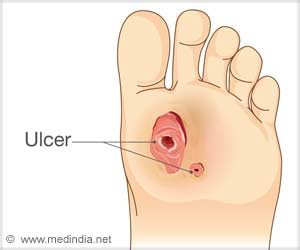Discover how smart socks with advanced sensors are revolutionizing diabetic foot care to prevent ulcers and amputations.
- Innovative electronic socks with BCG sensors monitor foot health in diabetic patients
- Early detection of abnormal walking patterns helps prevent foot ulcers and complications
- This wearable technology offers a non-invasive solution to improve diabetic foot care and patient outcomes
Electronic sock detects unhealthy walking style
Go to source). This isn’t your average athletic wear. Embedded with sophisticated sensors, these smart socks act as vigilant guardians, constantly monitoring your feet. Imagine a silent alarm system that detects potential problems before they snowball. That’s the promise of electronic socks – a potential game-changer in the fight against diabetic foot complications.
With an estimated 537 million people worldwide battling diabetes, the need for effective preventative measures is paramount.
This article delves into the details of this exciting research. We’ll explore how the electronic sock’s ingenious design and functionality could revolutionize diabetic foot care, offering patients a powerful tool to protect their well-being and improve their quality of life.
Every 30 seconds, a lower limb is lost to diabetes. #preventamputation #diabetescare #medindia’
Stepping Up Foot Care: Smart Socks with High-Tech Sensors
A new wearable technology, electronic sock designed to detect abnormal walking patterns associated with diabetes-related neurological foot complications is demonstrating significant potential in preventing foot ulcers and the need for amputation. This innovative research was introduced at European Heart Rhythm Association (EHRA) 2024, a scientific conference hosted by the European Society of Cardiology (ESC), marking a promising advancement for diabetic patients with impaired circulation in the legs.Dr. Ki Hong Lee from Chonnam National University Hospital in Gwangju, Republic of Korea, who led the study, highlighted that diabetes often alters an individual’s walking style, known as gait, which can lead to serious foot problems.
Patients with diabetes frequently apply excess pressure on the front of the foot (metatarsal area) rather than the heel while walking, predisposing them to foot ulcers that may become infected and ultimately result in amputation.
Early detection of these walking abnormalities using an electronic sock could facilitate timely intervention, enabling patients to learn healthier walking patterns to prevent such complications.
Diabetes affects approximately 1 in 10 individuals globally, totaling around 537 million people, substantially increasing their risk of various cardiovascular diseases, including peripheral artery disease, alongside other complications like foot issues.
The condition damages nerves and blood vessels due to high blood sugar levels, leading to symptoms like numbness, tingling, and pain, often difficult to detect in the early stages. Consequently, minor injuries such as cuts or ulcers can escalate into severe infections, particularly challenging to heal due to compromised blood flow, potentially culminating in gangrene and lower limb amputation.
Study Findings: Validating the Effectiveness of BCG Socks
The study explored the efficacy of a sock integrated with a ballistocardiogram (BCG) sensor in distinguishing between healthy individuals and those with diabetes. The BCG sensor detects body movement induced by the heart pumping blood and has the potential to measure heart rate and foot pressure during walking.Twenty patients with diabetes and 20 non-diabetic controls participated in the study. Each participant wore the BCG sock for 40 seconds while standing and 40 seconds while walking, enabling measurement of heart rate and assessment of foot pressure distribution. Concurrently, participants underwent an electrocardiogram (ECG) to accurately determine heart rate, considered the gold standard in cardiology diagnostics.
The BCG sock demonstrated high accuracy, with heart rate measurements correlating closely with ECG results (correlation coefficient of 0.99), validating its reliability as a heart rate measurement tool. The foot pressure distribution analysis aimed to identify differences between diabetic and non-diabetic individuals, as well as variations within diabetic patients based on nerve or blood vessel damage.
Patients with diabetes exhibited increased pressure on the metatarsal area compared to non-diabetic participants, particularly those with impaired blood circulation (as indicated by a lower ankle-brachial index score).
Future Implications: Transforming Diabetes Management
Dr. Lee emphasized that the BCG sock provides a straightforward and non-invasive method to identify diabetic patients at risk of foot complications, enabling targeted gait training interventions to prevent adverse outcomes. This innovative technology holds promise in improving the management and prevention of diabetes-related foot issues, potentially reducing the need for invasive procedures like amputation.In essence, the electronic sock with its BCG sensor transcends a simple piece of clothing; it becomes a powerful preventive tool. By facilitating early detection and intervention, it empowers diabetic patients and their caregivers to become active participants in safeguarding foot health.
This groundbreaking research in wearables technology paves the way for a future where technology becomes seamlessly integrated into diabetic care, potentially reducing the devastating toll of foot complications. As further research validates its effectiveness, the widespread adoption of electronic socks has the potential to significantly improve the lives of millions living with diabetes and preventing lower limb amputations.
Reference:
- Electronic sock detects unhealthy walking style - (https://www.eurekalert.org/news-releases/1039984)
Source-Medindia












